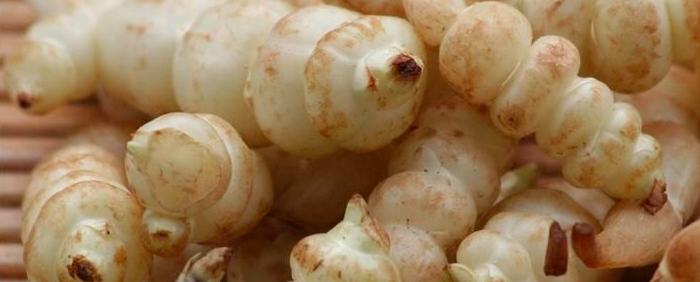
| The term ” crosne ” appeared in the language in 1882. It derives from Crosnes, name of the city where it was first cultivated in France.
The term ” epiary ” refers to the herringbone shape of the flower stem. |
| Not an artichoke! Although it is sometimes called ” Chinese artichoke “, crosne has no relation to artichoke, except that some find it somewhat similar flavor. |
The genus Stachys , or epiary, includes many species, some of which were once used in medicine. The S. affinis species is native to northern China where it has been cultivated for a very long time. However, it was not until the XIX th century that its small tubers whose shape is reminiscent of the “Michelin man”, will be known and cultivated in Europe.
Although it has never been widely consumed in the West, the crosne will still know a certain popularity in France between the two world wars, before falling into oblivion, probably because of its low productivity and the difficulty relating to harvesting it. With the evolution of in vitro culture techniques, which have made it possible to regenerate the species, and the current interest in “forgotten” vegetables, it is once again present on the stalls of French markets. It is also grown commercially in Malaysia, India, Korea, Japan, Russia, North and South America, South Africa and New Zealand.
Despite this, this original vegetable is still rare in our markets. Since it is considered a luxury product, it is found in specialty shops and Asian grocery stores, or on the menu of high-end restaurants.
Culinary uses
Choose well
The tubers should be firm, not rubbery, and milky white, with no pronounced brown spots. They are offered from November to April.
Preparation
Wash them and, if necessary, rub them in a cloth with coarse salt if soil remains in the folds. Remove the brownish ends. We don’t peel the crosnes.
Culinary dishes
- As a salad. Add it raw to salads, which will give it crunch. It goes wonderfully with slices of a firm fruit (pear or apple), lamb’s lettuce leaves and pieces of roasted hazelnuts. It can also be blanched for five minutes in boiling water before preparing it for salad.
- Jumped . It can replace the water chestnut in oriental stir-fry dishes. You can also simply brown it in butter with garlic and parsley, or in olive oil with asparagus tips.
- Roast. You can roast it in the oven with other spring root vegetables – parsnips, Jerusalem artichoke, salsify, scorsoner …
- Gratinated. Brown it in olive oil and brown it in the oven with Parmesan cheese, Gruyère cheese or any other cheese of your choice.
- In tempura . With other vegetables and seafood.
- Add it, half an hour before the end of cooking, to stews , curries or tagines.
- The marinate in olive oil, lemon juice and a little tamari or soy sauce and input use or as an appetizer. It can also be preserved in plum vinegar, as in Japan, or in another vinegar of your choice.
- He gets along well with herbs which, like him, emerge early in the spring, in particular, chives and sorrel.
Conservation
Refrigerator: a few days in a plastic bag. However, the crosne keeps poorly above ground, it is best to consume it as soon as possible after purchase.
Cellar: it can be kept for a few weeks in wet sand or peat moss.
Organic gardening
The crosne is very easy to produce in the vegetable patch. Rustic in zone 5 (in the extreme south of Quebec), it can be cultivated in colder regions on the condition of protecting it with a good mulch during the winter.
It is propagated by dividing the roots or, more frequently, by planting tubers from the previous harvest in the spring or fall.
Spacing: 30 cm. Depth: 8 cm to 10 cm.
pH: 6.6 to 7.5; moist but well-draining soil enriched with decomposed manure or compost; full sun or partial shade exposure.
It is practically impossible to harvest all the tubers, so that once it is installed, it is difficult to get rid of it. It is therefore important to choose the place where it will be cultivated, preferably in a flower bed far from the rest of the vegetable patch. It can also be grown in pots, choosing a large format (30 cm in diameter and more) so that it can grow at ease.
To obtain large tubers, cut the stems 15 cm when they reach 30 cm in height. It is sometimes necessary to do this a few times during the season.
Ensure that the plant never runs out of water, as it does not tolerate drought well.
The tubers take five to seven months to grow. Harvesting takes place from the end of October to April. In Quebec, where it is difficult to go to the garden during the coldest months, it is generally harvested late in the fall, then early in the spring, along with the Jerusalem artichoke.